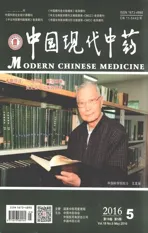基于UPLC-Q-TOF-MS技术分析石吊兰全草化学成分△
2016-09-25胡峻齐梦蝶张权秦振娴康利平南铁贵杨健袁媛詹志来刘勇
胡峻,齐梦蝶 ,张权,秦振娴,康利平,南铁贵,杨健,袁媛,詹志来*,刘勇*
(1.北京中医药大学,北京 100102;2.中国中医科学院 中药资源中心 道地药材国家重点实验室培育基地,北京 100700)
·基础研究·
基于UPLC-Q-TOF-MS技术分析石吊兰全草化学成分△
胡峻1,齐梦蝶1,张权1,秦振娴1,康利平2,南铁贵2,杨健2,袁媛2,詹志来2*,刘勇1*
(1.北京中医药大学,北京 100102;
2.中国中医科学院 中药资源中心 道地药材国家重点实验室培育基地,北京 100700)
目的:建立石吊兰全草化学成分的一种超高效液相色谱-四极杆飞行时间串联质谱联用技术分析方法。方法:80%甲醇-水溶液超声提取石吊兰,经Waters ACQUITY UPLC-BEH-C18S色谱柱(100 mm×2.1 mm,1.7 μm),以0.1%甲酸水-乙腈为流动相梯度洗脱,检测波长为210~400 nm,ESI负离子模式检测,根据精确分子量及碎片信息,结合数据库匹配进行结构鉴定。结果:从石吊兰全草中共鉴定出48个成分,其中42个苯乙醇苷类化合物、3个黄酮类化合物、3个其他类型化合物,有14个化合物为苦苣苔科中首次发现。结论:本研究首次对石吊兰化学成分进行整体研究,为该植物的深入研究奠定基础。
液质联用;石吊兰;化学成分
石吊兰LysinotuspauciflorusMaxim.为苦苣苔科吊石苣苔属石吊兰的全草,别名黑乌骨、石豇豆、石泽兰等,产于四川西部,生于山谷林中石上,海拔700~1 400 m,全株有祛风止咳、消食健脾等功效[1]。石吊兰民间多常用,主要用来治疗风湿骨痛、咳喘痰多及跌打损伤等症。石吊兰主要成分为黄酮和苯乙醇苷类成分[2-3]。目前对于石吊兰的化学成分研究较少,尤其是整体的化学成分研究还未见报道。超高效液相色谱串联四极杆飞行时间质谱(UPLC-Q-TOF-MS)具有分离速度快、灵敏度高、可提供精确相对分子量等优点,可以在缺乏对照品的情况下对化学成分进行解析。本研究采用UPLC-Q-TOF-MS联用技术对石吊兰中的化学成分进行鉴别分析,为该植物的进一步研究提供参考。
1 仪器与材料
1.1 仪器
ACQUITYI-Class 超高效液相色谱仪-Waters Xevo-G2-S Q-TOF MS 质谱系统(美国Waters公司)、Waters ACQUITY UPLC-BEH-C18S色谱柱(100 mm×2.1 mm,1.7 μm,美国Waters公司)、BSA224S型万分之一分析天平(德国Sartorius公司)、Centrifuge 5415D型离心机(德国Eppendorf公司)、SB-800-DTD型超声清洗机,超声功率500 W(宁波新芝生物科技股份有限公司)、Pacific T-Ⅱ型超纯水仪(美国Thermo公司)。水为超纯水,甲醇、乙腈为色谱纯(美国Fishier Scientific公司),其余试剂均为分析纯,0.22 μm疏水PTFE微孔滤头(Millipor公司,美国)。
1.2 材料
对照品有Acteoside、Calceolarioside B、Forsythoside B、Plantamajoside(成都曼斯特生物科技有限公司,纯度≥98%)。
石吊兰采集于湖南安化,经中国科学院植物研究所李振宇研究员鉴定为吊石苣苔属石吊兰LysionotuspauciflorusMaxim.,样品存放于中国中医科学院中药资源中心。
2 方法
2.1 供试品和对照品溶液的制备
2.1.1 供试品溶液制备 取石吊兰药材,粉碎,过40目筛,精密称取药材粉末2.0 g置具塞三角瓶中,加入80%甲醇水溶液15 mL,超声(功率500 W)提取1 h,放至室温,补重。样品用12 000 r·min-1离心10 min,取上清液,过0.22 μm微孔滤膜,供分析用。
2.1.2 对照品溶液制备 精密称取各种对照品适量,置10 mL容量瓶中,加适量甲醇超声使其溶解,再加甲醇至刻度,摇匀,0.22 μm疏水PTFE微孔滤头过滤,备用。
2.2 液相和质谱条件
2.2.1 液相色谱条件 色谱柱为Waters ACQUITY UPLC-BEH-C18(100 mm×2.1 mm,1.7 μm);流动相为0.1%甲酸水(A)-乙腈(B),梯度洗脱(0~5 min,5%~10%B;5.5~15 min,40%~65%B;18~23 min,70%~100%B;23~26 min,100%B;26~26.1 min,100%~5%B;26.1~28.5 min,5%B);流速为0.5 mL·min-1;柱温为0 ℃;进样量为1 μL。检测波长为190~400 nm。
2.2.2 质谱条件 Waters Xevo-G2-S Q-TOF MS 质谱系统,采用电喷雾离子源(ESI),负离子模式扫描,毛细管电压为2000 V,锥孔电压为 40 V,除溶剂气体为氮气,900 L·h-1,除溶剂温度为450 ℃,离子源温度为 100 ℃,扫描范围为m/z50~1500 Da,扫描时间为0.2 s,碰撞气体为氩气。低能量扫描时碰撞能量为6 eV,高能量扫描时碰撞能量为25~45 eV。准确质量数用leucine enkephalin作校正液。MassLynx 4.1液质系统控制软件(Waters公司)。
3 结果与分析
3.1 UPLC-Q-TOF-MS全扫描的基峰离子流色谱结果
为了更全面地检测石吊兰药材中所含的化合物信息,对提取溶剂、色谱条件、质谱条件等进行了优化,选择最优的条件对石吊兰及对照品进行LC-MS分析。其中负离子模式下显示出更为丰富的信息,总离子流图见图1。
3.2 石吊兰UPLC-Q-TOF-MS分析及鉴定
将数据导入Masslynx 4.1软件中,根据负离子模式一级质谱的分子离子峰得到化合物的相对分子质量,计算元素组成;再根据二级质谱信息,结合对照品的色谱保留时间、软件自带的数据库以及Chemspider(http://www.chemspider.com/)及Scifinder(https://scifinder.cas.org/)得到候选化合物。结合DAD特征光谱及文献[4-35],从石吊兰总离子流图中选择相应较明显的峰进行鉴定,共鉴定了48个化合物,其中有42个为苯乙醇苷类化合物、3个为黄酮类化合物、3个为其他类型化合物,有14个化合物为苦苣苔科中首次发现,见表1。

注:A.全部总离子流;B.9~14 min总离子流。图1 负离子模式下UPLC-Q-TOF-MS分析石吊兰总离子流图

表1 UPLC-Q-TOF-MS鉴定分析石吊兰全草中化学成分(负离子模式)

表1(续)

表1(续)
注:*为经对照品对照确定的成分,#为首次在苦苣苔科中发现的成分。
从表1的结果可以观察到,石吊兰中含有较多的同分异构体。本文采用化合物的ClogP参数对其同分异构体进行区分,举例如下。
化合物11、12和16:准分子离子峰均为m/z771.23[M-H]-,推测三者为同分异构体,二级质谱为m/z609.18[M-H-C6H10O5]-,447.15[M-H-C6H10O5-C9H8O3]-,315.11[M-H-C6H10O5-C9H8O3-C5H8O4]-,m/z179.03、161.02为咖啡酰基的碎片离子。根据文献[7-9]推测三者为2-(3,4-dihydroxyphenyl)ethyl-3-O-β-D-glucopyranosyl-6-O-(2,3,4,5-tetrahydroxycyclopentyl)-4-[(2E)-3-(3,4-dihydroxyphenyl)-2-propenoate]-β-D-glucopyranoside、rashomoside A或2-(3,4-dihydroxyphenyl)ethyl-O-D-apio-β-D-furanosyl-(1→3)-O-[β-D-glucopyranosyl-(1→6)]-4-[(2E)-3-(3,4-dihydroxyphenyl)-2-propen-oate]-β-D-glucopyranoside,计算3个化合物Clogp分别为-3.4、-3.1,-1.8,结合出峰顺序推测化合物11为2-(3,4-dihydroxyphenyl)ethyl-3-O-β-D-glucopyranosyl-6-O-(2,3,4,5-tetrahydroxycyclopen-tyl)-4-[(2E)-3-(3,4-dihydroxyphenyl)-2-propeno-ate]-β-D-glucopyranoside,12为rashomoside A,16为2-(3,4-dihydroxyphenyl)ethyl-O-D-apio-β-D-furanosyl-(1→3)-O-[β-D-glucopyranosyl-(1→6)]-4-[(2E)-3-(3,4-dihydroxyphenyl)-2-prope-noate]-β-D-glucopyranoside。
化合物17、19和22:准分子离子峰均为m/z609.18[M-H]-,推测三者都为同分异构体,二级质谱m/z447.15[M-H-C9H8O3]-,315.11[M-H-C9H8O3-C5H8O4]-,m/z179.03、161.02为咖啡酰基的碎片离子。根据文献[13-15]推测化合物三者为2-(3,4-dihydroxyphenyl)ethyl-2-O-D-apio-β-D-furan-osyl-4-[(2E)-3-(3,4-dihydroxyphenyl)-2-propeno-ate]-β-D-glucopyranoside、calceolarioside C或calceo-ralarioside E,计算3个化合物Clogp分别为-2.0、-1.5、-0.2,结合出峰顺序推测化合物17为2-(3,4-dihydroxyphenyl)ethyl-2-O-D-apio-β-D-furanosyl-4-[(2E)-3-(3,4-dihydroxyphenyl)-2-propenoate]-β-D-glucopyranoside,19为calceolario-side C,22为calceoralarioside E。
化合物20:准分子离子峰为m/z639.19[M-H]-,二级质谱m/z477.16[M-H-C9H8O3]-,315.11[M-H-C9H8O3-C6H10O5]-,m/z179.03、161.02为咖啡酰基的碎片离子,根据对照品比对,化合物20为plantamajoside,其可能的裂解规律见图2。

图2 Plantamajoside可能的裂解途径(负离子模式)
4 讨论
本研究首次运用超高效液相色谱串联四极杆飞行时间质谱技术对石吊兰中化学成分进行分析,根据质谱及精确分子量,参考石吊兰化学成分的研究及天然产物数据库搜索等方法,共鉴定了48个成分。石吊兰中含有较多同分异构体,本文采用化合物的Clogp参数对其同分异构体进行了有效的区分。
本研究表明石吊兰中含有丰富的苯乙醇苷类成分,而苯乙醇苷类成分是一类具有良好医疗价值的化合物,具有抗氧化、抗炎、抗病毒、抗菌、抗肿瘤、免疫调节等作用[36-38],尤其以抗氧化活性最为显著。对石吊兰化学成分的研究及药理和构效关系研究将对石吊兰植物资源开发利用具有实际意义。
[1] 中国药材公司.中国中药资源志要[M].北京:科学出版社,1994:1177.
[2] LIU Y,WAGNER H,BAUER R.Nevadensinglycosidesfrom Lysionotus pauciflorus[J].Phytochemistry,1996,42(4):1203-1205.
[3] Liu Y,Wagner H,Bauer R.Phenylpropanoids and flavonoid glycosides fromLysionotuspauciflorus[J].Phytochemistry,1998,48(2):339.
[4] Liu P,Deng R X,Duan H Q,et al.Phenylethanoid glycosides from the roots ofPhlomisumbrosa[J].J Asian Nat Prod Res,2009,11(1):69-74.
[5] Juliao,Lisieux de S,Piccinelli,et al.Phenylethanoid glycosides fromLantanafucatawith in vitro anti-inflammatory activity[J].J of Nat Prod,2009,72(8):1424-1428.
[6] Liu Y,Seligmann O,Wagner H,et al.Paucifloside,a new phenylpropanoid glycoside fromLysionotuspauciflorus[J].Nat Prod Lett,1995,7(1):23-28.
[7] Zubair,Muhammad,Nybom H,et al.Detection of genetic and phytochemical differences between and within populations ofPlantagomajorL.(plantain)[J].Scientia Horticulturae(Amsterdam,Netherlands),2012,136:9-16.
[8] Zhou Z L,Zhang H L.Phenolic and iridoid glycosides from the rhizomes ofCyperusrotundusL.[J].Med Chem Res,2013,22(10):4830-4835.
[9] Li C T,Liu Y Q,Abdulla,et al.Determination of phenylethanoid glycosides inLagotisbrevitubaMaxim.by high-performance liquid chromatography-electrospray ionization tandem mass spectrometry[J].Anal Lett,2014,47(11):1862-1873.
[10] Kiem P V,Quang T H,Huong T T,et al.Chemical constituents ofAcanthusilicifoliusL.and effect on osteoblastic MC3T3E1 cells[J].Arch Pharm Res,2008,31(7):823-829.
[11] Yang J H,Kondratyuk T P,Jermihov K C,et al.Bioactive compounds from the fernLepisoruscontortus[J].J Nat Prod,2011,74(2):129-136.
[12] Mathuram V,Patra A,Kundu A B.A phenyl propanoid glycoside fromNyctanthesarbortristis[J].J Ind Chem Soci,1997,74(8):653-655.
[13] Lin S,Wang S J,Liu M T,et al.Glycosides from the stem bark ofFraxinussieboldiana[J].J Nat Prod,2007,70(5):817-823.
[14] Stanoeva J P,Stefova M,Stefkov G K,et al.Chemotaxonomic contribution to theSideritisspecies dilemma on the Balkans[J].Biochem Syst Ecol,2015,61:477-487.
[15] Nazemiyeh,H,Shoeb M,Movahhedin N,et al.Phenolic compounds and their glycosides fromStachysschtschegleevii(Lamiaceae)[J].Biochem Syst Ecol,2006,34(9):721-723.
[16] Miyase T,Mimatsu A.Acylated iridoid and phenylethanoid glycosides from the aerial parts ofScrophularianodosa[J].J Nat Prod,1999,62(8):1079-1084.
[17] Taskova R M,Kokubun T,Ryan K G,et al.Phenylethanoid and iridoid glycosides in the New Zealand snow hebes(Veronica,Plantaginaceae)[J].Chem Pharm Bull,2010,58(5):703-711.
[18] Suo M R,Ohta T,Takano F,et al.Bioactive phenylpropanoid glycosides fromTabebuiaavellanedae[J].Molecules,2013,18:7336-7345.
[19] 郗峰,邓君,王彦涵.藏药短管兔耳草中1个新苯乙醇苷类化合物[J].中国中药杂志,2009,34(16):2054-2056.
[19] Wang Li N,Guo D X,Wang,S Q,et al.Phenolic glycosides from the Chinese Liverwort Reboulia hemisphaerica[J].Hel Chim Acta,2011,94(6):1146-1152.
[21] Morikawa T,Pan Y,Ninomiya K,et al.Acylated phenylethanoid oligoglycosides with hepatoprotective activity from the desert plantCistanchetubulosa[J].Bioor Med Chem,2010,18(5):1882-1890.
[22] Zhou F Y,She J,Wang Y G.Synthesis of a benzyl-protected analog of arenarioside,a trisaccharide phenylpropanoid glycoside[J].Carbohydr Res,2006,341(15):2469-2477.
[23] Lei L,Jiang Y,Liu X M,et al.New glycosides fromCistanchesalsa[J].Helv Chim Acta,2007,90(1):79-85.
[24] Kernan M R,Amarquaye A,Chen J L,et al.Antiviral phenylpropanoid glycosides from the medicinal plantMarkhamialutea[J].J Nat Prod,1998,61(5):564-570.
[25] Yadava R N,Satnami D K.Chemical constituents fromCassiaoccidentalisLinn[J].Indian J Chem(Sec.B):Org Chem Including Med Chem,2011,50B(8):1112-1118.
[26] Bagrii A K,Kurmaz B V,Litvinenko V I.New bioside of quercetin[J].Khim Prir Soedin,1966,2(2):85-90.
[27] 张忠立 左月明 徐璐,等.三白草黄酮类化学成分的研究[J].中草药,2011,42(8):1490-1493.
[28] Porter E A,Kite G C,Veitch N C,et al.Phenylethanoid glycosides in tepals of Magnolia salicifolia and their occurrence in flowers of Magnoliaceae[J].Phytochemistry,2015,117:185-193.
[29] Liu M M,Zhou L,He P L,et al.Discovery of flavonoid derivatives as anti-HCV agents via pharmacophore search combining molecular docking strategy[J].Euro J Med Chem,2012,52:33-43.
[30] Adhikari B,Devkota H P,Joshi K R,et al.Two new diacetylene glycosides:bhutkesoside A and B from the roots ofLigusticopsiswallichiana[J].Nat Prod Res,2015.DOI:10.1080/14786419.2015.1118635.
[31] Tanikawa T,Fridman M,Zhu W J,et al.Using Biological Performance Similarity To Inform Disaccharide Library Design[J].J Am Chem Soc,2009,131(14):5075-5083.
[32] Jin Q L,Jin H G,Shin J E,et al.Phenylethanoid glycosides fromDigitalispurpureaL.[J].Bull Kore Chem Soc,2011,32(5):1721-1724.
[33] Jiang T Fu,Ou Q Y,Shi Y.Separation and determination of phenylpropanoid glycosides fromPedicularisspecies by capillary electrophoresis[J].J Chromatogr A,2003,986(1):163-167.
[34] Fan L,Liao C H,Li S G,et al.Phenylethanoid and secoiridoid glycosides from the leaves ofLigustrumpurpurascens[J].Phytochem Lett,2015,13:177-181.
[35] Yuan J Q,Qiu L,Zou L H,et al.Two new phenylethanoid glycosides fromCallicarpalongissima[J].Helv Chim Acta,2015,98(4):482-489.
[36] Hu X P,Shao M M,Song X,et al.Anti-influenza virus effects of crude phenylethanoid glycosides isolated fromligustrumpurpuras.censvia inducing endogenous interferon-γ[J].J Ethnopharmacol,2015,179:128-136.
[37] Wang Y J,Zhou S M,Xu G,et al.Interference of phenylethanoid glycosides fromCistanchetubulosawith the MTT assay[J].Molecules,2015,20(5):8060-8071.
[38] Encalada M A,Rehecho S,Ansorena,Di,et al.Antiproliferative effect of phenylethanoid glycosides from Verbena officinalis L.on colon cancer cell lines[J].LWT-Food Sci Technol,2015,63(2):1016-1022.
StudyonChemicalConstituentsinWholeHerbofLysinotuspauciflorusbyUPLC-Q-TOF-MS
HU Jun1,QIMengdie1,ZHANGQuan1,QINZhenxian1,KANGLiping2,NANTiegui2,YANGJian2,YUANYuan2,ZHANZhilai2*,LIUYong1*
(1.BeijingUniversityofChineseMedicine,Beijing100102,China;2.NationalResourceCenterforChineseMateriaMedica,ChinaAcademyofChineseMedicalSciences,StateKeyLaboratoryBreedingBaseofDao-diHerbs,Beijing, 100700,China)
Objective:To analyze the chemical components in the whole herb ofLysinotus.pauciflorusMaxim by Ultra high performance liquid chromatography quadrupole time-of-flight mass spectrometry (UPLC-Q-TOF-MS).Methods:Crude drug were extracted with 80% methanol in water. A Waters ACQUITY UPLC-BEH-C18S column (2.1 mm×100 mm, 1.7 μm) was used with a gradient elution of acetonitrile-water containing 0.1% formic acid. The mass spectrometry equipped with ionization source was used and the data was collected under negative ion mode. And the components identification was applied by the precise molecular weight and fragmentation information, combined with a database match.Results:Forty-eight compounds were identified with 42 phenylethanoid glycosides, 3 flavonoids and 3 other compounds, among them, 14 compounds were firstly identified in Gensneriaceae plant.Conclusion:We have quite completely identified the components in the whole herb ofL.pauciflorusfor the first time, which lay the foundation for the further study and utilization of the medicinal resources.
UPLC-Q-TOF-MS;LysinotuspauciflorusMaxim.;chemical constituents
2016-03-17)
中医药行业科研专项(201407003)
*
刘勇,教授,研究方向:药用植物亲缘学、中药质量与开发,Tel:(010) 84738656,E-mail:yliu0126@aliyun.com;詹志来,助理研究员,研究方向:中药资源鉴定与评价,Tel:(010)64014411-2847,E-mail:zzlzhongyi@163.com
10.13313/j.issn.1673-4890.2016.5.002
